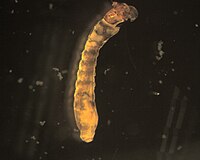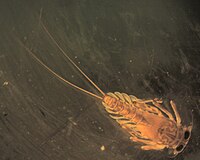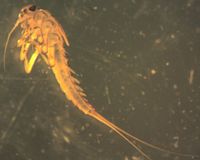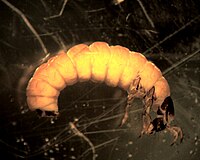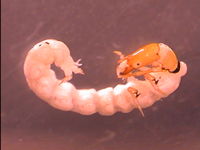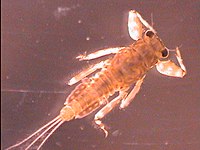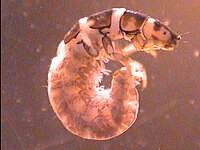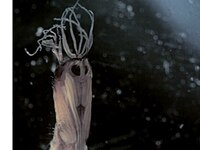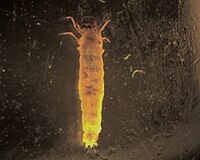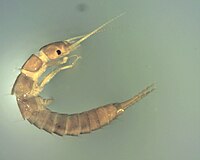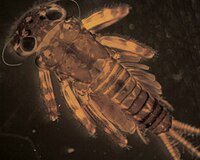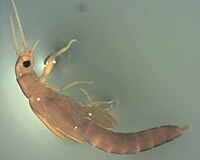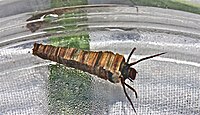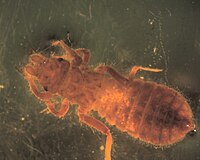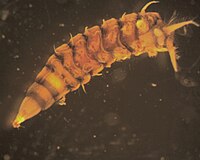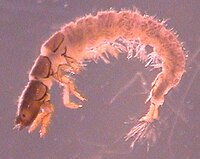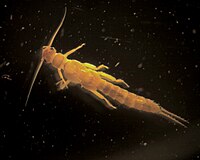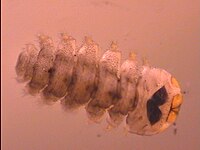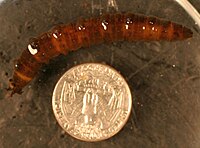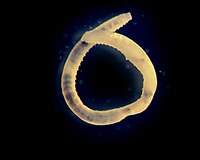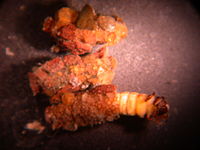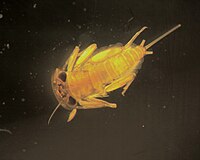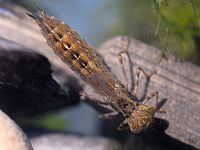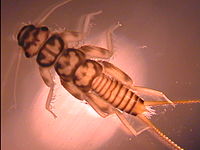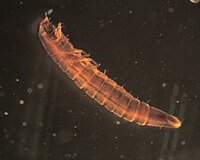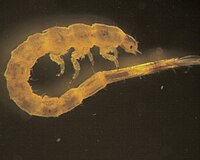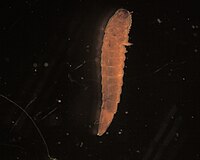Vermont EPSCoR's Streams Project; A Teacher Collaboration on WikiEducator
Openly shared content, practices, and developing resources from Vermont EPSCoR's Streams Project. Join this collaboration and make a difference!
 South Wheelock Branch of Passumpsic River |
|---|
|
| Stream code: | PSR_SWBrnch_1652 |
| Basin: | Passumpsic River |
| State or Province: | Vermont |
| Country: | USA |
| Latitude: | 44.545111 |
| Longitude: | -72.129808 |
| School: | Lyndon High School 2 |
The following are the most common invertebrates collected from this stream site.
Simuliidae
- Order
- Diptera
- Family
- Simuliidae
Simuliidae appear rather like bowling pins with heads. Relatively speaking, we collect few members of this family and have we have not identified them past family at this point.
Click here for a close up image of the heads.
Epeorus
- Order
- Ephemeroptera
- Family
- Heptageniidae
- Genus
- Epeorus
- Common name
- The Quill Gordon
- Tied fly
- Quill Gordon
This is the only Heptageniidae genus present in this area with two tails!
Chironomidae
- Order
- Diptera
- Family
- Chironomidae
- Common name
- Nonbiting midge
- Tied fly
- Griffith's Gnat
Midge larvae tend to be the most common macroinvertebrate at our sites. As with other Diptera, there are no true jointed legs. Chironomidae do have a pair of prolegs at each end and preserved individuals tend to curl into a 'C'. Identification past family requires slide-mounted heads. We have seen philopotamid caddisflies misidentified with the chironomids and we suspect that that happens when samples are being sorted from trays. Under a microscope, six prominent legs can be seen on members of the caddisfly family Philopotamidae.
More information on Philopotamidae.
Baetis
- Order
- Ephemeroptera
- Family
- Baetidae
- Genus
- Baetis
- Common name
- The Little Olive
- Tied fly
- Sawyer Pheasant Tail Nymph
This mayfly has three "tails" and a unique head shape. Its gills are oval shaped and insert dorsally. More mature nymphs have long, dark wing pads.
Image of the long, dark wing pads.
Glossosomatidae
- Order
- Trichoptera
- Family
- Glossosomatidae
- Common name
- saddlecase caddisfly
Larvae in this family build domed cases made of small rocks, and are often wider at segment 5. The pronotum is covered in dark, sclerotized plates, but there are either
no sclerites on the mesonotum, or the mesonotum is unsclerotized with the exception of a few patches. The anal proleg is broadly joined to segment 9; the anal claw has one or more accessory hooks. The
pronotal excision is small (approximately 1/3 anterolaterally) to accommodate the coxae.
Commonly encountered genera include Glossosoma and Agapetus.
Philopotamidae
- Order
- Trichoptera
- Family
- Philopotamidae
- Common name
- fingernet caddisflies
Philopotomidae are net-spinning filtering collectors. A casual observer might sort them with Chironomidae, but a close look reveals six jointed legs. The faint white 'T' shaped labrum extending from the front of the head past the mandibles is diagnostic for the family (it is sometimes withdrawn and hard to see).
Image of the faint white 'T' shaped labrum. Common genera include Dolophilodes, Wormaldia, and Chimarra.
Ephemerellidae
- Order
- Ephemeroptera
- Family
- Ephemerellidae
- Common name
- spiny crawler mayflies
- Tied fly
- Blue-Winged Olive
The mayfly
Ephemerellidae is distinguished by the absence of gills on the second abdominal segment; individuals either have gills on segments 3-7 or 4-7. Some may have operculate (plate-like) gills on the fourth segment, though in many the gills are of identical size. The most commonly found genera include
Drunella,
Ephemerella, and
Serratella.
More information on the genera Drunella, Ephemerella, and Serratella.
Ceratopsyche
- Order
- Trichoptera
- Family
- Hydropsychidae
- Genus
- Ceratopsyche
Ceratopsyche has a
forked foretrochantin. The foretrochantin is the projection at the uppermost portion of the foreleg. The leg may need to be pulled away from the body to expose this feature.
Ceratopsyche have a
large pair of sclerites underneath the prosternum. Note: the large single sclerite is the prosternal plate. Biologists have gone back and forth between lumping this genus into
Hydropsyche and splitting it back out. ITIS currently lists it as a genus (Feb 2013) but we are aware of a recent paper that lumped it under
Hydropsyche.
Diptera
- Order
- Diptera
- Tied fly
- Griffith's Gnat
Pupae from the order Diptera are typically found in small numbers at every site. These can be identified further, but we do not.
Lepidostomatidae
- Order
- Trichoptera
- Family
- Lepidostomatidae
- Common name
- The Little Plain Brown Sedge
- Tied fly
- Elk Hair Caddis
These have lateral humps on the first abdominal segments, but lack a dorsal hump. The dorsal of the first two thoracic segments are sclerotized. They are frequently found in four-sided cases made of square pieces of detritus.
Images of the first two thoracic segments and the four-sided cases.
Perlodidae
- Order
- Plecoptera
- Family
- Perlodidae
Stoneflies in the Perlodidae family do not have branching gills from leg bases. When observing their mouthparts, the glossae and paraglossae form a large three-pronged notch, or opening. The hind wing pads are divergent. Cerci, or "tails," are as long or longer than the abdomen.
Images of mouthparts, thehind wing pads and the ventral view.
Maccaffertium
- Order
- Ephemeroptera
- Family
- Heptageniidae
- Genus
- Maccaffertium
- Common name
- The March Brown
- Tied fly
- March Brown
This genus of
Heptageniidae is distinguished by its gills on the seventh abdominal segment, which are reduced to slender filaments. Gills on segments 1-6 are truncated.
Images of the slender filaments, and the truncated gills.
Leuctridae
- Order
- Plecoptera
- Family
- Leuctridae
- Common name
- rolled-winged stoneflies or needle fly
- Tied fly
- Halford's Willow Fly
This family of stonefly is fairly slender by stonefly standards. The divergent wing pads are a helpful characteristic. Leuctridae are similar in overall shape to the Capniidae; however, Leuctridae often do not have pleural folds. If they are present, they only extend from abdominal segments 1-7. The genus
Leuctra are recognized by abdominal terga with posterior fringes of short hairs and last few segments with longer hairs.
Images of the divergent wing pads, Capniidae, abdominal terga and a ventral view can be seen here.
Brachycentrus
- Order
- Trichoptera
- Family
- Brachycentridae
- Genus
- Brachycentrus
- Common name
- The Olive Dun Caddis
- Tied fly
- Deer Hair Caddis
These larvae are typically found with their legs extended out of their case for feeding. The cases are square in cross section and made of plant materials. Brachycentrus has 2 large sclerites on the metanotum. In fresh samples (preserved for less than one week) these organisms often have a pale green tint; live specimens are a more vivid green.
Gomphidae
- Order
- Odonata
- Family
- Gomphidae
- Common name
- clubtail dragonflies
Like other Odonata, members of this family have four wingpads. Like members of the sub-order Anisoptera, the abdomen terminates in five points. What distinguishes Gomphidae from Aeshnidae is the fact that Gomphidae has clubbed antennae.
Image of the four wingpads and the abdomen.
More information on Aeshnidae.
Athericidae
- Order
- Diptera
- Family
- Athericidae
- Common name
- water snipe flies
Members of the family Athericidae have wrinkled bodies with prolegs on the ventral side. Their mandibles- which can be seen by carefully cutting the head open- move parallel to each other. On the end of their abdomen there are two lobes fringed with setae. Our collections include just the single genus Atherix.
Image of the two lobes of the abdomen.
Cheumatopsyche
- Order
- Trichoptera
- Family
- Hydropsychidae
- Genus
- Cheumatopsyche
Cheumatopsyche has a
forked foretrochantin (as does
Ceratopsyche). The foretrochantin is the projection at the uppermost portion of the front leg closest to the head. The leg may need to be pulled away from the body to expose this feature.
Cheumatopsyche have a small or inconspicuous
pair of sclerites under the prosternal plate that are difficult to see. Contrast that with the
larger pair of sclerites found on Ceratopsyche. To access sclerites, it's best to gently pull the pronotum and mesonotum in opposite directions. Note: the large single sclerite is the prosternal plate.
Cheumatopsyche have only 2 types of
hair on the abdomen: long thin plain hairs and thicker club hairs, which are narrow close to the body and widen out at the distal end. Paired sclerites on the ninth abdominal segment are notched.
Chloroperlidae
- Order
- Plecoptera
- Family
- Chloroperlidae
- Common name
- The Yellow Sally
- Tied fly
- Yellow Sally
Stoneflies from the family Chloroperlidae have cylindrical banded abdomens. When observing their mouthparts, the glossae and paraglossae form a three-pronged (open) notch, and their hind wing pads are parallel (not divergent). Cerci have a vertical fringe of hairs pointing away from the abdomen. Setae on the pronotum are found primarily at the corners.
Blepharicera
- Order
- Diptera
- Family
- Blephariceridae
- Genus
- Blepharicera
- Common name
- net-winged midges
This dipteran is characterized by six prominent "suction cups" on its ventral side and has tufts on the sides of abdominal sections.
Image of the ventral side.
Tipulidae
- Order
- Diptera
- Family
- Tipulidae
- Common name
- The Crane Fly
- Tied fly
- Gangle Legs
Like other larvae from the order Diptera, members of the family Tipulidae (crane flies) lack legs. Tipulidae have retracted, difficult-to-see head capsules at one end, and a spiracular disk at the other end. The spiracular disk can sometimes look like a face leading to some confusion about which end is which. Upon gently cutting the head open, one can see that the mandibles are not parallel to each other, but rather move against each other.
The genera we've encountered include Antocha, Dicranota, Hexatoma, Limnophila, Molophilus, Pedecia and Tipula.
Oligochaeta
- Common name
- aquatic earthworms; black worms
Aquatic earthworms lack legs and are characterized by having 20 or more segments. Unlike leeches, they lack a suction disk. We collect members of two or more orders in this class as small numbers of stream sites and they are rarely numerous. They are more common at pond and lake sites.
Image of the 20 or more segments.
Neophylax
- Order
- Trichoptera
- Family
- Uenoidae
- Genus
- Neophylax
- Common name
- Fool's Caddis
- Tied fly
- Peeping Caddis
Neophylax are characterized by having a sclerotized pronotum and mesonotum. They build a case of coarse sand grains often with a pair of latteral pebbles or "ballast stones". The larvae are rather stout and the head is scrunched in between the limbs. The anal hooks are attached directly to the abdomen and they rarely come out of the case when preserved. On the ventral surface of the abdominal segments, one can see darkened ovals, known as the chloride epithelia. Like the
Limnephilidae, they have a prosternal horn, though it can sometimes be small. Also, they have a dorsal hump and two lateral humps on the first abdominal segment- be careful! Often times, these features can be
squished down or damaged in the sampling process. A larva removed from it's case is shown
here.
The feature that distinguishes Uenoidae from Limnephilidae is the mesonotum: on either side of the midline, the anterior margin is notched.
Because our samples were taken in summer, we found large numbers of Neophylax pre-pupae. We anticipate that there will be fewer present in the streams in late September and many of those sampled will be at the pupal or adult stage. Samples taken in October would tend to have more empty cases.
Rhithrogena
- Order
- Ephemeroptera
- Family
- Heptageniidae
- Genus
- Rhithrogena
- Tied fly
- Dark Blue Upright
This three-tailed genus of mayfly has whitish gills that appear fluffy; some species have bright red gills when alive. The gills on abdominal segments 1 and 7 are larger than the others and almost meet underneath the abdomen.
Click to view picture of the gills
Aeshnidae
- Order
- Odonata
- Family
- Anisoptera
- Common name
- Darner
- Tied fly
- Carey Special
All dragonflies have five points sticking out from the back end. Members of this family of dragonflies are distinctly long as can be seen in the photograph. Other common families tend to be a wider and flatter. If you pull out on the mouthparts under the head you'll see that they look flat in side view. If they look spoon-shaped then it is from a different family. Like other
Odonata, members of this family have four wingpads. Like members of the sub-order
Anisoptera, the abdomen terminates in five points. The prementum and palpal lobes of this dragonfly are flat when viewed from side.
Images of the four wingpads, the abdomen, the prementum and palpal lobes, and a view from the
the side.
Chloroperlidae
- Order
- Plecoptera
- Family
- Chloroperlidae
- Common name
- The Yellow Sally
- Tied fly
- Yellow Sally
Stoneflies from the family Chloroperlidae have cylindrical banded abdomens. When observing their mouthparts, the glossae and paraglossae form a three-pronged (open) notch, and their hind wing pads are parallel (not divergent). Cerci have a vertical fringe of hairs pointing away from the abdomen. Setae on the pronotum are found primarily at the corners.
Perlodidae
- Order
- Plecoptera
- Family
- Perlodidae
Stoneflies in the Perlodidae family do not have branching gills from leg bases. When observing their mouthparts, the glossae and paraglossae form a large three-pronged notch, or opening. The hind wing pads are divergent. Cerci, or "tails," are as long or longer than the abdomen.
Images of mouthparts, thehind wing pads and the ventral view.
Agnetina
- Order
- Plecoptera
- Family
- Perlidae
- Genus
- Agnetina
Agnetina nymphs have cylindrical, striped abdomens. Like other Plecoptera, they have 2 tails and 2 claws on each tarsus. This genus has three black dots (ocelli) on the top of the head. Click to see the
three ocelli on the dorsum of the head (3 black dots at joint with the pronotum). This stonefly is characterized by the
filamentous gills located in the "armpits". Another important feature is the paraglossae and glossae extending different lengths. The
occiput has a transverse row of evenly spaced little hairs.
Agnetina has another row of evenly spaced hairs on the posterior edge of
abdominal segment 7.
Stenelmis
- Order
- Coleoptera
- Family
- Elmidae
- Genus
- Stenelmis
The larvae of
Stenelmis, as in
Ordobrevia, have a sternum on the ventral side of the pronotum. The main difference between the two genera is in the antennae the second segment is less than twice as long as the first in
Stenelmis.
The adult Stenelmis has a clear separation between the thorax and abdomen as well as a more distinctly separate head as compared to other genera.
Click here to see pictures of the sternum and
antennae-
Dubiraphia
- Order
- Coleoptera
- Family
- Elmidae
- Genus
- Dubiraphia
The larvae of this genus are distinguished by the last abdominal segment, which is very elongated. Adults of this genus usually have prominent longitudinal markings on their elytra and, like adult
Optioservus, have a fringe of tomentum on their anterior tibia.
Image of the fringe of tomentum.
Optioservus
- Order
- Coleoptera
- Family
- Elmidae
- Genus
- Optioservus
The larvae of
Optioservus have open coxae, as determined by the straight definition between segments on the ventral side of the pronotum.
The adult Optioservus have a compact appearance, especially the head and thorax. There are also dorsal ridges and a characteristic diamond-shaped sutellum observable in the dorsal view.
Images of the straight definition between segments, the dorsal ridgesand the diamond-shaped scutellum.
Blepharicera
- Order
- Diptera
- Family
- Blephariceridae
- Genus
- Blepharicera
- Common name
- net-winged midges
This dipteran is characterized by six prominent "suction cups" on its ventral side and has tufts on the sides of abdominal sections.
Image of the ventral side.

